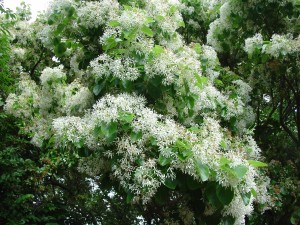 Chinese fringetree (Chionanthus retusus)
Chinese fringetree (Chionanthus retusus)
When in bloom in mid-spring (May), the fringetrees (Chionanthus spp.) definitely will catch your eye. Chinese fringetree (C. retusus), is one of the finest small to medium sized flowering trees, not to be confused with the U.S. native fringetree (C. virginicus) (USDA hardiness zones 5-9). Both produce spectacular white lacy flowers in late spring. Flower panicles are larger and showier on American fringetree, and its growth form is often wild without some annual pruning.
Over the past quarter century the Chinese form has developed a growing “fan base” among American gardeners. Its high gloss, dark green foliage holds its sheen through the spring and summer months and are disease and pest free. Fall color is non-distinct yellow and is rarely spectacular. The aged furrowed bark on Chinese fringetree is very attractive.
Fringetrees are dioecious; male flowers are non-fruiting while female flowers bear ½ inch long egg-shaped blue-black fruits (drupes). Seeds collected and sown in the fall will germinate 2-3 years later.
Chinese fringetree prefers a full sun location. It tolerates a wide range of soils provided they’re well-drained. A 3 to 5 gallon plant will grow to 25 to 30 feet tall and wide in 20 years. Two-year established plants demonstrate good drought tolerance. It performs better sited in light afternoon shade in southern climes.
‘Tokyo Tower’ is a columnar form that matures to 15 to 18 feet height and only 6 to 8 feet in width. ‘China Snow’ is a slow-growing shrub form from Tennessee nurseryman Don Shadow; it grows 8 feet tall and 5 feet wide in ten years with snowy white fringed blooms.
Caveat: People often confuse the name “fringetree” (Chionanthus) with “fringe flower” (Loropetalum)

 Posted in
Posted in 
